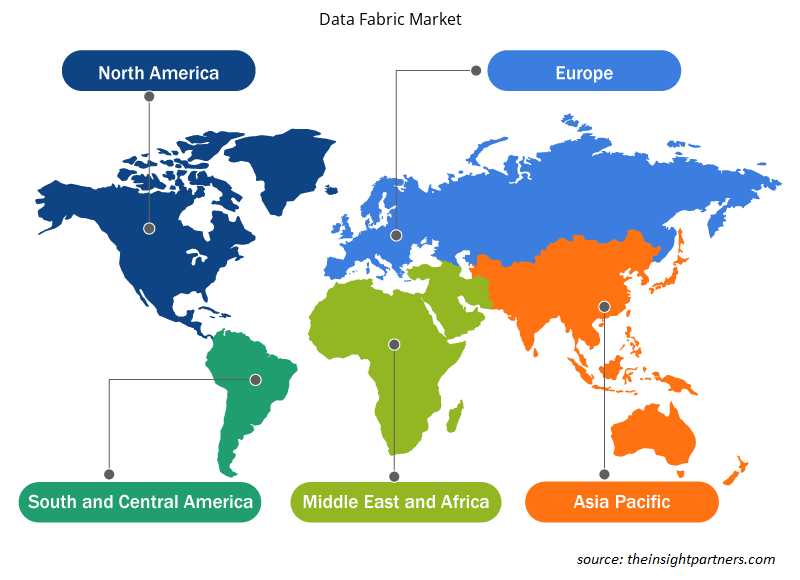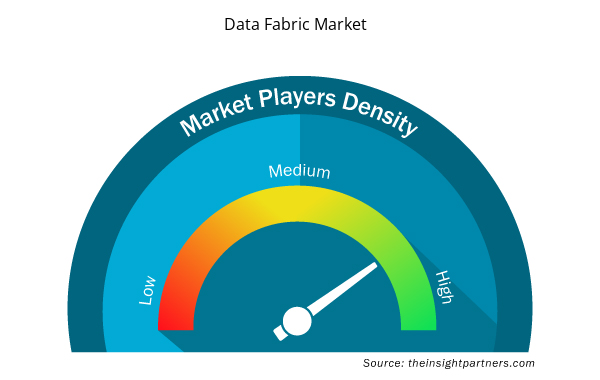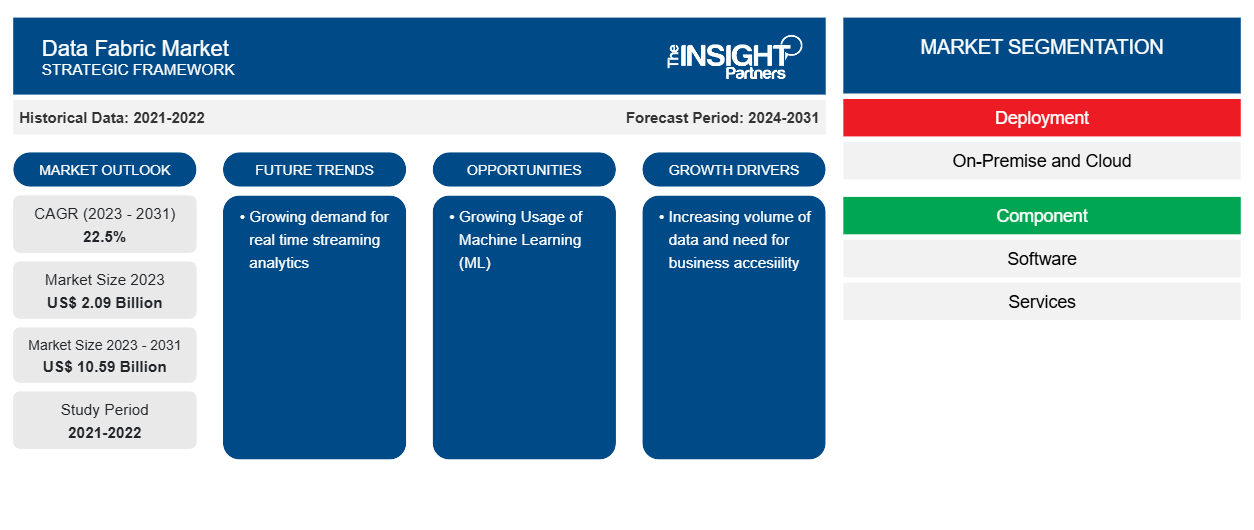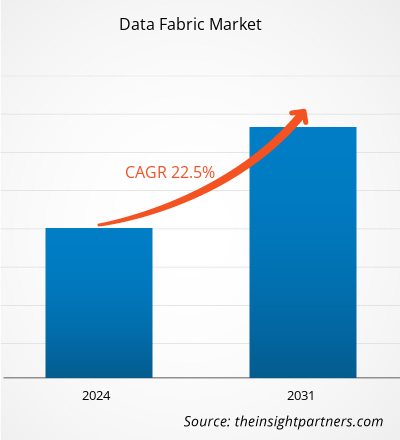Si prevede che il mercato Data Fabric crescerà da 2,09 miliardi di dollari nel 2023 a 10,59 miliardi di dollari entro il 2031; si prevede che si espanderà a un CAGR del 22,5% dal 2023 al 2031. Si prevede che la crescente domanda di analisi di streaming in tempo reale sarà una tendenza chiave nel mercato.
Analisi di mercato del Data Fabric
Il data fabric offre virtualizzazione dei dati, consentendo alle aziende di implementare un accesso senza interruzioni ai dati rendendoli accessibili a tutti. Con l'implementazione del data fabric, gli utenti aziendali possono accedere ai dati con una partecipazione minima dell'IT, con conseguente ambiente più rapido e semplice per l'accesso e lo scambio dei dati. Un data fabric logico ben progettato centralizza la sicurezza essenziale e la gestione dei dati. Pertanto, si prevede che il mercato del data fabric crescerà durante il periodo di previsione.
Panoramica del mercato del Data Fabric
Data Fabric è un sistema completo di integrazione e gestione dei dati che include architettura , strumenti di gestione e integrazione dei dati e dati condivisi per assistere le aziende nella gestione dei propri dati. Un data fabric offre un'esperienza utente unica e coerente e un accesso ai dati in tempo reale a ogni membro della rete globale di un'organizzazione. Data fabric è destinato ad assistere le aziende nella risoluzione di problemi di dati complessi e casi d'uso gestendo i dati su una varietà di applicazioni, piattaforme e posizioni. Data fabric fornisce accesso e condivisione dei dati senza attriti in un ambiente di dati disperso.
Personalizza questo report in base alle tue esigenze
Riceverai la personalizzazione gratuita di qualsiasi report, comprese parti di questo report, o analisi a livello nazionale, pacchetto dati Excel, oltre a usufruire di grandi offerte e sconti per start-up e università
- Scopri le principali tendenze di mercato in questo rapporto.Questo campione GRATUITO includerà analisi di dati che spaziano dalle tendenze di mercato alle stime e alle previsioni.
Driver e opportunità di mercato del Data Fabric
Aumento del volume dei dati per favorire la crescita del mercato
Ogni organizzazione incentrata sui dati richiede un approccio completo che affronti tempo, spazio, vari tipi di software e posizioni dei dati. I dati devono essere disponibili a coloro che ne hanno bisogno, anziché essere nascosti dietro firewall o sparsi in più luoghi. Le aziende richiedono una soluzione dati sicura, efficiente, coerente e a prova di futuro per migliorare la loro efficienza operativa. Pertanto, si prevede che la domanda di data fabric crescerà durante il periodo di previsione.
Crescente utilizzo dell'apprendimento automatico (ML)
Gli algoritmi ML possono monitorare le pipeline di dati e suggerire collegamenti e integrazioni rilevanti . Questi algoritmi estraggono informazioni dai dati mentre sono collegati alla struttura dei dati, esaminano tutti i dati aziendali e trovano collegamenti e correlazioni rilevanti. Fornire dati è uno degli aspetti più dispendiosi in termini di tempo nell'addestramento di un modello ML. La progettazione di Data Fabric rende i modelli ML più efficienti riducendo i tempi di preparazione dei dati. Migliora inoltre l'usabilità dei dati preparati in varie applicazioni e modelli. Le aziende distribuiscono i dati in locale, nel cloud e nell'IoT . La struttura dei dati consente un accesso limitato ai dati sicuri e migliora i processi ML. Pertanto, si prevede che l'applicazione di ML in Data Fabric alimenterà la crescita del mercato durante il periodo di previsione.
Tessuto di dati
Analisi della segmentazione del rapporto di mercato
I segmenti chiave che hanno contribuito alla derivazione dell'analisi di mercato di Data Fabric sono la copertura per distribuzione, componente, soluzione e utente finale.
- In base all'implementazione, il mercato è diviso in on-premise e cloud. Il segmento cloud ha guidato il mercato nel 2023.
- In base ai componenti, il mercato si divide in software e servizi
- In base alla soluzione, il mercato è suddiviso in scoperta dei dati, inserimento dei dati, orchestrazione dei dati, accesso ai dati del fabric, gestione dei dati e gestione del fabric e
- Sulla base degli utenti finali, il mercato è suddiviso in BFSI, IT e telecomunicazioni, vendita al dettaglio, assistenza sanitaria e farmaceutica e altri
Analisi della quota di mercato di Data Fabric per area geografica
In base alla regione, il mercato è segmentato in Nord America, Europa, Asia Pacifico, Medio Oriente e Africa, Sud e Centro America.
La regione nordamericana ha detenuto una quota importante del mercato del data fabric nel 2023 e si prevede che crescerà a un CAGR sostanziale durante il periodo di previsione. Questa crescita può essere attribuita alla presenza di numerosi market plater e all'adozione precoce dell'adozione tecnologica. Inoltre, si prevede che la regione Asia-Pacifico crescerà al CAGR più rapido durante il periodo di previsione. Questa crescita può essere attribuita al crescente numero di data center e alla crescente digitalizzazione.
Approfondimenti regionali sul mercato Data Fabric
Le tendenze regionali e i fattori che influenzano il mercato Data Fabric durante il periodo di previsione sono stati ampiamente spiegati dagli analisti di Insight Partners. Questa sezione discute anche i segmenti e la geografia del mercato Data Fabric in Nord America, Europa, Asia Pacifico, Medio Oriente e Africa e America meridionale e centrale.

- Ottieni i dati specifici regionali per il mercato Data Fabric
Ambito del rapporto di mercato di Data Fabric
| Attributo del report | Dettagli |
|---|---|
| Dimensioni del mercato nel 2023 | 2,09 miliardi di dollari USA |
| Dimensioni del mercato entro il 2031 | 10,59 miliardi di dollari USA |
| CAGR globale (2023-2031) | 22,5% |
| Dati storici | 2021-2022 |
| Periodo di previsione | 2024-2031 |
| Segmenti coperti | Per distribuzione
|
| Regioni e Paesi coperti | America del Nord
|
| Leader di mercato e profili aziendali chiave |
|
Densità degli attori del mercato: comprendere il suo impatto sulle dinamiche aziendali
Il mercato del Data Fabric Market sta crescendo rapidamente, spinto dalla crescente domanda degli utenti finali dovuta a fattori quali l'evoluzione delle preferenze dei consumatori, i progressi tecnologici e una maggiore consapevolezza dei vantaggi del prodotto. Con l'aumento della domanda, le aziende stanno ampliando le loro offerte, innovando per soddisfare le esigenze dei consumatori e capitalizzando sulle tendenze emergenti, il che alimenta ulteriormente la crescita del mercato.
La densità degli operatori di mercato si riferisce alla distribuzione di aziende o società che operano in un particolare mercato o settore. Indica quanti concorrenti (operatori di mercato) sono presenti in un dato spazio di mercato in relazione alle sue dimensioni o al valore di mercato totale.
Le principali aziende che operano nel mercato Data Fabric sono:
- Tecnologie Denodo
- Società IBM
- Società Informatica
- K2Visualizza
- NetApp, Inc.
- Società Oracle
Disclaimer : le aziende elencate sopra non sono classificate secondo un ordine particolare.

- Ottieni una panoramica dei principali attori del mercato Data Fabric
Notizie di mercato e sviluppi recenti di Data Fabric
Il mercato Data Fabric viene valutato raccogliendo dati qualitativi e quantitativi dopo la ricerca primaria e secondaria, che include importanti pubblicazioni aziendali, dati associativi e database. Di seguito sono elencati alcuni degli sviluppi nel mercato Data Fabric:
- LigaData, un fornitore leader nel panorama della tecnologia delle telecomunicazioni, sta rivoluzionando il settore dell'analisi dei dati delle telecomunicazioni con il lancio del suo nuovo LigaData Telecom Data Fabric 4.0 e delle app LigaData Telecom AI. Questi nuovi prodotti consentono alle aziende di telecomunicazioni e ai fornitori di servizi di comunicazione nelle loro iniziative di trasformare le loro attività da aziende di telecomunicazioni tradizionali in aziende di tecnologia agili basate su dati e AI, guidando al contempo la crescita dei ricavi, mantenendo la quota di mercato e migliorando l'esperienza del cliente. (Fonte: LigaData, comunicato stampa, febbraio 2024)
Copertura e risultati del rapporto di mercato di Data Fabric
Le previsioni di mercato di Data Fabric sono stimate in base a vari risultati di ricerche secondarie e primarie, come pubblicazioni aziendali chiave, dati di associazioni e database. Il rapporto di mercato "Data Fabric Market Size and Forecast (2021–2031)" fornisce un'analisi dettagliata del mercato che copre le seguenti aree:
- Dimensioni e previsioni del mercato Data Fabric a livello globale, regionale e nazionale per tutti i segmenti di mercato chiave coperti dall'ambito
- Tendenze del mercato di Data Fabric, nonché dinamiche di mercato quali driver, vincoli e opportunità chiave
- Analisi dettagliata delle cinque forze PEST/Porter e SWOT
- Analisi di mercato di Data Fabric che copre le principali tendenze di mercato, il quadro globale e regionale, i principali attori, le normative e i recenti sviluppi del mercato
- Analisi del panorama industriale e della concorrenza che copre la concentrazione del mercato, l'analisi della mappa di calore, i principali attori e gli sviluppi recenti nel mercato Data Fabric
- Profili aziendali dettagliati.
- Analisi storica (2 anni), anno base, previsione (7 anni) con CAGR
- Analisi PEST e SWOT
- Valore/volume delle dimensioni del mercato - Globale, regionale, nazionale
- Industria e panorama competitivo
- Set di dati Excel



Report Coverage
Revenue forecast, Company Analysis, Industry landscape, Growth factors, and Trends

Segment Covered
This text is related
to segments covered.

Regional Scope
North America, Europe, Asia Pacific, Middle East & Africa, South & Central America

Country Scope
This text is related
to country scope.
Domande frequenti
The global Data Fabric market was estimated to grow at a CAGR of 22.5% during 2023 - 2031.
Growing demand for real-time streaming analytics is the major trend in the market.
The report can be delivered in PDF/PPT format; we can also share an Excel dataset based on the request.
Denodo Technologies, IBM Corporation, Informatica Corporation, K2View, NetApp, Inc., Oracle Corporation, SAP SE, Software AG, Teradata, and Hewlett Packard Enterprise Development LP (HPE) are the major market players.
Some of the customization options available based on the request are additional 3–5 company profiles and a country-specific analysis of 3–5 countries of your choice. Customizations are to be requested/discussed before making final order confirmation, as our team would review the same and check the feasibility.
The increasing volume of data and the need for business accessibility are the major factors that drive the global Data Fabric market.
Trends and growth analysis reports related to Technology, Media and Telecommunications : READ MORE..
The Insight Partners performs research in 4 major stages: Data Collection & Secondary Research, Primary Research, Data Analysis and Data Triangulation & Final Review.
- Data Collection and Secondary Research:
As a market research and consulting firm operating from a decade, we have published and advised several client across the globe. First step for any study will start with an assessment of currently available data and insights from existing reports. Further, historical and current market information is collected from Investor Presentations, Annual Reports, SEC Filings, etc., and other information related to company’s performance and market positioning are gathered from Paid Databases (Factiva, Hoovers, and Reuters) and various other publications available in public domain.
Several associations trade associates, technical forums, institutes, societies and organization are accessed to gain technical as well as market related insights through their publications such as research papers, blogs and press releases related to the studies are referred to get cues about the market. Further, white papers, journals, magazines, and other news articles published in last 3 years are scrutinized and analyzed to understand the current market trends.
- Primary Research:
The primarily interview analysis comprise of data obtained from industry participants interview and answers to survey questions gathered by in-house primary team.
For primary research, interviews are conducted with industry experts/CEOs/Marketing Managers/VPs/Subject Matter Experts from both demand and supply side to get a 360-degree view of the market. The primary team conducts several interviews based on the complexity of the markets to understand the various market trends and dynamics which makes research more credible and precise.
A typical research interview fulfils the following functions:
- Provides first-hand information on the market size, market trends, growth trends, competitive landscape, and outlook
- Validates and strengthens in-house secondary research findings
- Develops the analysis team’s expertise and market understanding
Primary research involves email interactions and telephone interviews for each market, category, segment, and sub-segment across geographies. The participants who typically take part in such a process include, but are not limited to:
- Industry participants: VPs, business development managers, market intelligence managers and national sales managers
- Outside experts: Valuation experts, research analysts and key opinion leaders specializing in the electronics and semiconductor industry.
Below is the breakup of our primary respondents by company, designation, and region:

Once we receive the confirmation from primary research sources or primary respondents, we finalize the base year market estimation and forecast the data as per the macroeconomic and microeconomic factors assessed during data collection.
- Data Analysis:
Once data is validated through both secondary as well as primary respondents, we finalize the market estimations by hypothesis formulation and factor analysis at regional and country level.
- Macro-Economic Factor Analysis:
We analyse macroeconomic indicators such the gross domestic product (GDP), increase in the demand for goods and services across industries, technological advancement, regional economic growth, governmental policies, the influence of COVID-19, PEST analysis, and other aspects. This analysis aids in setting benchmarks for various nations/regions and approximating market splits. Additionally, the general trend of the aforementioned components aid in determining the market's development possibilities.
- Country Level Data:
Various factors that are especially aligned to the country are taken into account to determine the market size for a certain area and country, including the presence of vendors, such as headquarters and offices, the country's GDP, demand patterns, and industry growth. To comprehend the market dynamics for the nation, a number of growth variables, inhibitors, application areas, and current market trends are researched. The aforementioned elements aid in determining the country's overall market's growth potential.
- Company Profile:
The “Table of Contents” is formulated by listing and analyzing more than 25 - 30 companies operating in the market ecosystem across geographies. However, we profile only 10 companies as a standard practice in our syndicate reports. These 10 companies comprise leading, emerging, and regional players. Nonetheless, our analysis is not restricted to the 10 listed companies, we also analyze other companies present in the market to develop a holistic view and understand the prevailing trends. The “Company Profiles” section in the report covers key facts, business description, products & services, financial information, SWOT analysis, and key developments. The financial information presented is extracted from the annual reports and official documents of the publicly listed companies. Upon collecting the information for the sections of respective companies, we verify them via various primary sources and then compile the data in respective company profiles. The company level information helps us in deriving the base number as well as in forecasting the market size.
- Developing Base Number:
Aggregation of sales statistics (2020-2022) and macro-economic factor, and other secondary and primary research insights are utilized to arrive at base number and related market shares for 2022. The data gaps are identified in this step and relevant market data is analyzed, collected from paid primary interviews or databases. On finalizing the base year market size, forecasts are developed on the basis of macro-economic, industry and market growth factors and company level analysis.
- Data Triangulation and Final Review:
The market findings and base year market size calculations are validated from supply as well as demand side. Demand side validations are based on macro-economic factor analysis and benchmarks for respective regions and countries. In case of supply side validations, revenues of major companies are estimated (in case not available) based on industry benchmark, approximate number of employees, product portfolio, and primary interviews revenues are gathered. Further revenue from target product/service segment is assessed to avoid overshooting of market statistics. In case of heavy deviations between supply and demand side values, all thes steps are repeated to achieve synchronization.
We follow an iterative model, wherein we share our research findings with Subject Matter Experts (SME’s) and Key Opinion Leaders (KOLs) until consensus view of the market is not formulated – this model negates any drastic deviation in the opinions of experts. Only validated and universally acceptable research findings are quoted in our reports.
We have important check points that we use to validate our research findings – which we call – data triangulation, where we validate the information, we generate from secondary sources with primary interviews and then we re-validate with our internal data bases and Subject matter experts. This comprehensive model enables us to deliver high quality, reliable data in shortest possible time.


 Ottieni un campione gratuito per questo repot
Ottieni un campione gratuito per questo repot